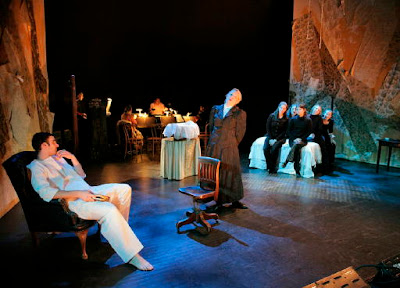
Paul Corujo (John) and Jennifer Holbrook (The Woman) in The Yellow Wallpaper, Peabody Chamber Opera, photo by Cory Weaver |
The Peabody Chamber Opera is doing exactly what a collegiate opera company should, giving its students the opportunity to perform in a range of operas, from familiar favorites to lesser-known masterpieces to world premieres. A collegiate company, which is not as dependent on ticket revenue as a professional one and which has a dedicated audience base in the friends and relatives of its young performers, should take chances. That sense of daring, then, is also transmitted to the students, who cut their teeth on something other than the same hundred chestnuts that make up so much of the average professional company's season. Last weekend at Baltimore Theater Project, PCO presented its latest production, the world premiere of a new opera, The Yellow Wallpaper, by Catherine Reid.
The libretto by Judith Lane adapts a short story of the same title by Charlotte Perkins Gilman, about a Victorian woman's struggles with the rest cure prescribed for her nervous disorder following childbirth. The story has been embraced by later generations as a monument of 19th-century feminism, getting read a lot in Women's Studies classes, and this one-act chamber opera is not the only attempt to adapt the story to another medium. On a recent post on The Yellow Wallpaper by opera blogger La Cieca, a commenter notes a 1989 opera of The Yellow Wallpaper by Ronald Perera. The story was also adapted for television in the same year, and a new film adaptation is being released later this year.
Both librettist and composer come from a music theater background, and the roots of the musical tradition are occasionally visible, especially in the more or less neotonal score. Reid kept her orchestration to a minimum, to maximize the stage space, since the players have to be placed at the back of the pitless performance area. 
The Yellow Wallpaper, Peabody Chamber Opera,
photo by Cory Weaver |
Other than extended, atmospheric solos for flute (Elena Yakovleva), most of the meat of the instrumental score was handled aptly by the piano (Miaomiao Wang) and with various sounds, some of them infelicitous, from a synthesizer (played well by Jerfi Aji).
Reid also gave considerable color to the score with a chorus of five female voices, who sometimes sat with the instrumental ensemble and other times wandered the stage interacting with the characters. They mostly sing in Stimmung-like clusters and the five women demonstrated extraordinary unity of color and blend as a group, which generally excelled their few solo moments. Most striking of the quintet was the stratospheric soprano of Yi-Wen Hung, a model of light, clear high singing. The women are present from the beginning of the opera, voices inside the protagonist's head, both inspiring her writing (she is an author) and signifying her descent into madness during the hours of prescribed rest and solitude. Bit by bit, she imagines women in the patterns of the wallpaper ("one of those sprawling flamboyant patterns committing every artistic sin," as it is described in the story) and hears their voices.
The two lead roles were both sung on Saturday night by first-year Master's students. The standout performance of the evening was soprano Jennifer Holbrook as the Woman, whose performance was both dramatically believable and vocally full of promise in its natural appeal and impressive strength and consistency. Her counterpart, baritone Paul Corujo, was believably stodgy as the husband, John, but had a somewhat stilted tone with considerable uncertainty in the upper register. Associate conductor Jong-hun Bae, conducting only the Saturday night performance, led the ensemble with poise, benefiting from the thorough preparation of music director JoAnn Kulesza. Garnett Bruce's direction provided the most scenic variation in the single set, designed by Kel Millionie. The overall look was drained of color, with stark white and black costumes balanced by the drab wallpaper of the room. Masks for the female quintet, recalling the pattern of the wallpaper, captured the uneasy sense of the women "creeping" out of the wall.
Sadly, The Yellow Wallpaper is probably not going to amount to much. This is not to say that I would not welcome the chance to hear it again, but its appeal is just not strong enough to elicit great enthusiasm. As a ghost story with a background of psychological disturbance, the model is Benjamin Britten's adaptations of Henry James short stories, The Turn of the Screw and Owen Wingrave, of which The Yellow Wallpaper falls lamentably short. This is no surprise since, as has been pointed out here before, most new operas throughout history have failed. In the 18th century, for example, the Paris Opéra premiered new operas each season, canceling the ones that failed and replacing them with revivals of trusted favorites by Lully and other composers. Opera companies should be premiering more new operas, even knowing full well that most of them will ultimately fail. It is the only way to keep opera alive.
Peabody's next opera production will be Mozart's The Magic Flute (March 12 to 15), in Friedberg Hall. The set designs will be created in collaboration with the Illustration Department of the Maryland Institute College of Art.























































2 comments:
I'm curious to know if there were any bows in the direction of Lovecraft--who named Yellow Wallpaper as one story with important influence on his own writing. In a sense, Nightmare on Elm Street is a direct descedant of Yellow Wallpaper.
Well, interesting question, but nothing that I saw. However, it's been a long time since I read any Lovecraft.
Post a Comment